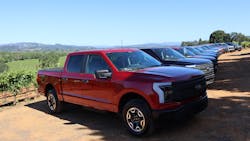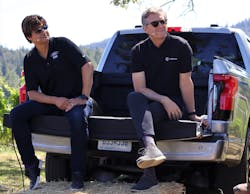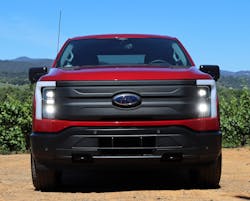SANTA ROSA, California—Ford Pro CEO Ted Cannis says his company has an ambitious goal—100% uptime for its commercial customers.
To support that noble mission, Ford Pro already is helping fleet customers monitor gasoline-powered vehicle data, and design and install charging infrastructure for the battery-electric F-150 Lightning Pro trucks it began delivering last month.
Cannis predicts fleet managers will be ecstatic to receive them.
“With electric vehicles, what’s even better for many customers is, one, there is a lot less maintenance, so you don’t have the time lost bringing it into the shop; and two, you can have that [charging] system running, and you power at home, or here at Dutton Ranch, on the grid, and you don’t have to have lost time going to gas stations,” Cannis said during a recent discussion panel in Sonoma County wine country. “So there’s a chance to get a huge upgrade in uptime.”
To learn more about this potential uptime upgrade after the executive discussion, Fleet Maintenance went one-on-one with Cannis, who opened up about “multi-make” compatibility, bedside manners, chip shortages, and more.
[Questions and answers are edited for length and clarity.]
Fleet Maintenance: What do you tell fleets when discussing the Lightning’s value proposition, and the differences between maintaining battery-electric and gasoline-powered vehicles?
Ted Cannis: On the maintenance side, we estimate they’re going see something like 40% less scheduled maintenance over the life of the vehicle, and probably less than that. So when we’re going through all of that analysis, one of the main things for us is convenience, because most of our 125,000 fleet customers in the U.S. turn their fleets roughly 10-15% a year, so it’s going to be a long time before they rotate out. So everything we’re doing with the software, service, charging, financing, etc., is designed to, one, have both internal-combustion and battery-electric [compatibility], and two, to be multi-make [OEM agnostic]. And also, we’re building electric vehicles to support all upfits because it’s a big pain in the butt if the upfit you already have, or your accessories or your gear, don’t fit, and you can’t spread it across your existing trucks.
And then from a training standpoint, we have 660 commercial vehicle centers in North America dedicated to commercial customers, with longer hours and higher bays, and 95% of those are EV certified. And now we’re rolling out a huge fleet of mobile service [E-Transit] vans. So with the guys here [at Dutton Ranch], the dealer who supports them has one of them. We’re up to almost 500 now, and going to 1,000 by the end of the year. What that allows us to do, for any customer, is go to them. So instead of you and an employee following in a vehicle, dropping them off, and wasting all of that time, we can go to them, have the dealer come out to them, and fix them there. And that’s even better with electric, because they don’t have to go up on the lift hardly at all.
There’s no exhaust to worry about. So you can come out, do the brakes, windshield wipers, or whatever you need, and just do it in the field.
FM: Will fleets with their own shops be working on these trucks?
TC: Inside the batteries, not so much. You’ll want to come in and do it. You’re not going to be doing very much in there, but if you wanted to, you’ve got high-voltage wiring to deal with. And then some of its software, which we’ll handle mostly with over-the-air updates.
FM: It seems like mechanics need to be technologists these days. What training is required to work on these vehicles?
TC: There’s a lot of sensor calibration. But the packs themselves have an eight-year warranty, or 100,000 miles, so not much is going on with the pack. When we designed the F-150, for the Lightning, most of the stuff inside the cabinet, and the rest [of the vehicle], was designed to be the same. Why would I want to pay extra for a small run of seats when I have America’s top-selling vehicle? I can get huge scale on a lot of the components. So the components that are working in the cabin, like the cameras, the sensors, and others, are the same on both [EV and gas] vehicles. And that’s going to allow fleets with the knowledge they already have, in our huge customer base, to transition right over.
See also: Riding the Lightning Pro: First Impressions
FM: We hear a lot about mechanic shortages. Will Lightning adoption be a good thing for short-handed shops?
TC: It’s a different kind of mechanic. You’re doing your traditional bodywork, and brakes, and everything else in there, but you’re not doing much in the battery pack. So that’s the difference. Now, we’re all struggling for technicians. If you’re a technician, man, you are the happiest guy. Everybody wants a technician right now. We’re full-time, and with our mobile service, you have to have good bedside manners, right? Because you’re not dropping the vehicle off late, they’re coming to you, and taking care of customers directly.
FM: We also know electric vehicles have fewer mechanical parts. Given the supply-chain disruptions causing parts shortages, is that another potential benefit for fleets?
TC: There are definitely fewer parts, with the upkeep of the powertrain. But over time, as a natural interest as well, we’re looking at the battery supply, and trying to get battery chemicals to be local here in North America; so more convenient, secure, and sustainable mining for lithium, cobalt, nickel, etc., also is a key part of the strategy—and the recycling. So we made a big investment with Redwood Materials, so we could reuse up to almost 95% of the battery. We’re recycling them, and returning the materials—and the copper as well—to the back end.
FM: So it sounds like supply-chain issues will still exist. They’ll just be different ones.
TC: Different issues. The chip one, I think, is going to be with us for a while. It’s not ending all that soon.
FM: Is there anything else you tell prospective fleet adopters about Lightning maintenance?
TC: There’s just less to do. There are fewer moving parts. You don’t have to spend all that time on it because the battery’s well-sealed. So it’s a lot easier.


